
The Chilean flamingo is a species of large flamingo at a height of 110–130 cm (43–51 in) closely related to the American flamingo and the greater flamingo, with which it was sometimes considered conspecific. The species is listed as Near Threatened by the IUCN.

Hypericum perforatum, commonly known as St John's wort, is a flowering plant in the family Hypericaceae. It is a perennial plant that grows up to one meter tall, with many yellow flowers that have clearly visible black glands around their edges, long stamens, and three pistils. Probably a hybrid between the closely related H. attenuatum and H. maculatum that originated in Siberia, the species is now found worldwide. It is native to temperate regions across Eurasia and North Africa, and has been introduced to East Asia, Australia, New Zealand, and parts of North and South America. In many areas where it is not native, H. perforatum is considered a noxious weed. It densely covers open areas to the exclusion of native plants, and is poor grazing material. As such, methods for biocontrol have been introduced in an attempt to slow or reverse the spread of the species.
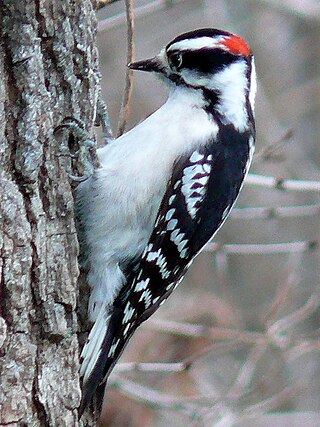
The downy woodpecker is a species of woodpecker, the smallest in North America. Length ranges from 14 to 18 cm. Downy woodpeckers primarily live in forested areas throughout the United States and Canada, with the exception of deserts in the southwest and the northern tundra. The bird nests in tree cavities and feeds primarily on insects, although it supplements its diet with seeds and berries. The downy woodpecker is very similar in appearance to the hairy woodpecker, although they are not closely related.

Acer pseudoplatanus, known as the sycamore in the British Isles and as the sycamore maple in the United States, is a species of maple tree native to Central Europe and Western Asia. It is a large deciduous, broad-leaved tree, tolerant of wind and coastal exposure.

The least weasel, little weasel, common weasel, or simply weasel is the smallest member of the genus Mustela, family Mustelidae and order Carnivora. It is native to Eurasia, North America and North Africa, and has been introduced to New Zealand, Malta, Crete, the Azores, and São Tomé. It is classified as least concern by the IUCN, due to its wide distribution and large population throughout the Northern Hemisphere.

The common blue butterfly or European common blue is a butterfly in the family Lycaenidae and subfamily Polyommatinae. The butterfly is found throughout the Palearctic and has been introduced to North America. Butterflies in the Polyommatinae are collectively called blues, from the coloring of the wings. Common blue males usually have wings that are blue above with a black-brown border and a white fringe. The females are usually brown above with a blue dusting and orange spots.

The death's head cockroach is a species of cockroach belonging to the family Blaberidae. It is often confused with the discoid cockroach, Blaberus discoidalis, due to its similar appearance. It is distinguished by jet black cloak-like marking on its wings and a skull-shaped, amber/black marking on its pronotum. The name death's head comes from the markings on the top of the pronotum: "cranii", which is Latin for "of the head", and "fer", meaning "carry" or "carrier". Due to their unique appearance and certain characteristics, they make an easy to care for pet or display insect for entomologists and hobbyists.
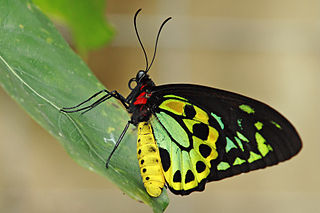
Ornithoptera euphorion, the Cairns birdwing, is a species of birdwing butterfly endemic to Queensland, and is Australia's largest endemic butterfly species. Other common names include Cooktown birdwing and northern birdwing. The names Cairns and Cooktown in its common name reference the Australian cities in the region where this butterfly is found.

Dorcus parallelipipedus, the lesser stag beetle, is a species of stag beetle found in Europe.

The ebony jewelwing is a species of broad-winged damselfly. One of about 150 species of Calopterygidae, it is found in the eastern U.S. and southeastern Canada, ranging west to the Great Plains. Other common names include black-winged damselfly.
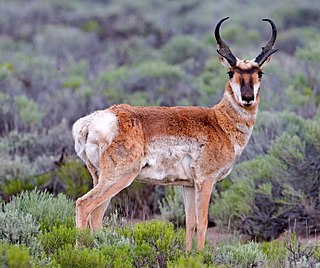
The pronghorn is a species of artiodactyl mammal indigenous to interior western and central North America. Though not an antelope, it is known colloquially in North America as the American antelope, prong buck, pronghorn antelope and prairie antelope, because it closely resembles the antelopes of the Old World and fills a similar ecological niche due to parallel evolution. It is the only surviving member of the family Antilocapridae.

Melyridae are a family of beetles of the superfamily Cleroidea.

Hypericum androsaemum, the shrubby St. John's wort, is a flowering plant in the family Hypericaceae. Commonly called tutsan or sweet-amber, the species is cultivated as an ornamental plant because of its striking red-tinted foliage, bright yellow petals, and its large clusters of fruit. Cultivars like 'Albury Purple' and 'Golden Tutsan' which have leaves with more pronounced purple and golden coloring, respectively.
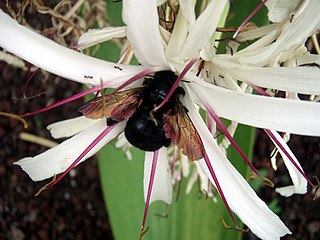
Xylocopa sonorina, the valley carpenter bee or Hawaiian carpenter bee, is a species of carpenter bee found from western Texas to northern California, and the eastern Pacific islands. Females are black while males are golden-brown with green eyes.

Anthidium manicatum, commonly called the European wool carder bee, is a species of bee in the family Megachilidae, the leaf-cutter bees or mason bees.
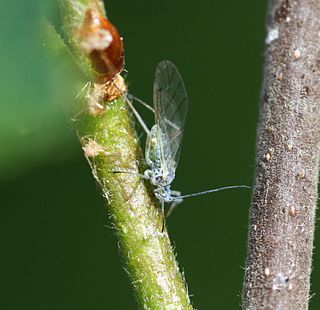
Euceraphis betulae, the birch aphid or silver birch aphid, is a species of aphid in the order Hemiptera. It is a tiny green insect with a soft body and wings. It is found living on the European silver birch tree where it feeds and multiplies on the buds and leaves by sucking sap.

The Eurasian hoopoe is the most widespread species of the genus Upupa. It is a distinctive cinnamon coloured bird with black and white wings, a tall erectile crest, a broad white band across a black tail, and a long narrow downcurved bill. Its call is a soft "oop-oop-oop".

Hylaeus agilis is a bee species in the family Colletidae. It is endemic to New Zealand. This species is found throughout the country and visits the flowers of a wide variety of plant species, both native and introduced.

Brachypterolus pulicarius, known generally as the toadflax flower-eating beetle or antirrhinum beetle, is a species of short-winged flower beetle in the family Kateretidae. It is found in Europe and Northern Asia and North America.
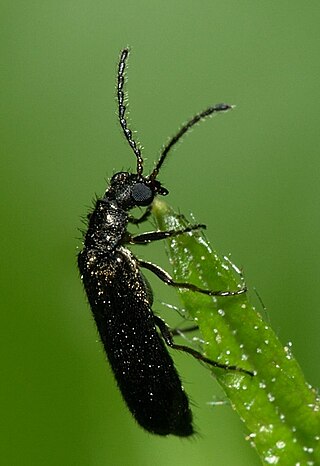
Dasytes plumbeus is a species of beetle that is native to the Paleartic, but has also been introduced to North America.





















